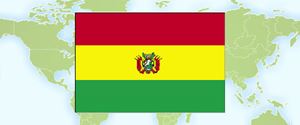- Trending:
- Pope Leo Xiv
- |
- Israel
- |
- Trump
- |
- Social Justice
- |
- Peace
- |
- Love

RELIGION LIBRARY
Bolivia

The country has an area of 424,164 square miles and a population of 9.5 million. According to a 2001 survey conducted by the National Statistical Institute, 78 percent of the population is Catholic, 16 percent Protestant or evangelical, 3 percent follow other religions of Christian origin, 2.5 percent practice no religion, and less than 0.2 percent claim affiliation with non-Christian faiths, including Islam, the Baha'i Faith, Judaism, Buddhism, and Shinto. Of those who habitually practice their religion, 56.5 percent are Catholic, 36.5 percent Protestant or evangelical, and 7 percent belong to other Christian groups. In urban areas, 80 percent of the population is Catholic, while 14 percent is Protestant or evangelical. In rural areas, 74 percent of the population is Catholic, while 20.5 percent is Protestant or evangelical.
Approximately 55 percent of the population identifies itself as indigenous: 29 percent Quechua, 24 percent Aymara, 1 percent Chiquitano, and 1 percent Guaraní. Several other indigenous groups are present, although none represents more than 0.5 percent of the population. An estimated 30 percent of the population identifies itself as mestizo (of mixed indigenous and European ancestry) and 15 percent as white. Percentages vary significantly based on the definition used and sociopolitical factors. For example, according to a 2009 poll conducted by the Bolivian Foundation for Multiparty Democracy, as much as 60 percent of the population identifies itself as mestizo.
The indigenous population is higher in rural areas, where the formal Catholic Church tends to be weaker due to a lack of resources and to indigenous cultural resistance to church efforts to replace traditional attitudes with more orthodox Catholic practices and beliefs. For many individuals, identification with Catholicism for centuries has coexisted with attachment to traditional beliefs and rituals, with a focus on the Pachamama or Mother Earth figure, and on Ekeko, a traditional indigenous god of luck, harvests, and general abundance, whose festival is celebrated widely on January 24.
The Church of Jesus Christ of Latter-day Saints (Mormons) estimates membership in the Mormon Church at approximately 153,000. Mormons are present throughout the country and have a particularly large presence in Cochabamba, where their temple is one of the largest in the world. The approximately 650-member Jewish community is spread throughout the country and has synagogues in La Paz, Cochabamba, and Santa Cruz. There are an estimated 1,000 Muslims, both converts and immigrants. Muslims have cultural centers that also serve as mosques in La Paz, Santa Cruz, and Cochabamba, predominantly for Sunni Muslims. Shi'a Muslims have a small but growing community in La Paz. Korean immigrants have their own Christian church in La Paz and founded a university with evangelical and Presbyterian ties in Santa Cruz. There are Buddhist and Shinto communities throughout the country as well as a substantial Baha'i community.
| Population | Population (2009 est.) 9,775,246 |
| Religious Demographics | Roman Catholic 95%, Protestant (Evangelical Methodist) 5% |
| Ethnic Groups | Ethnic Groups Quechua 30%, mestizo (mixed white and Amerindian ancestry) 30%, Aymara 25%, white 15% |
| Languages | Languages Spanish 60.7% (official), Quechua 21.2% (official), Aymara 14.6% (official), foreign languages 2.4%, other 1.2% (2001 census) |
| Country Flag |  |










